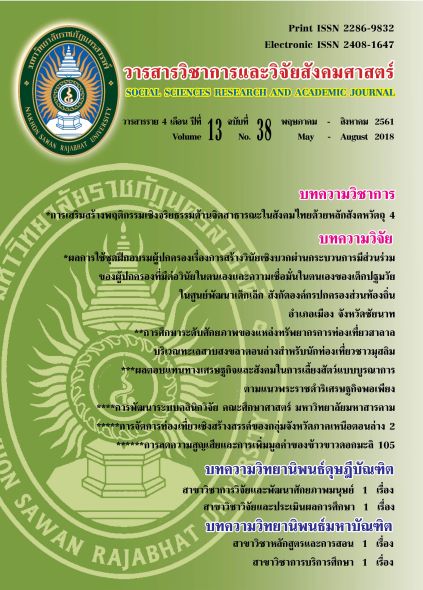การลดความสูญเสียและการเพิ่มมูลค่าของข้าวขาวดอกมะลิ 105 Reducing Losses and Value Added of Dok Mali 105 Rice
Main Article Content
Abstract
การวิจัยในครั้งนี้มีวัตถุประสงค์เพื่อ 1) วิเคราะห์ความสูญเสียข้าวขาวดอกมะลิ 105 2) เปรียบเทียบต้นทุนการเก็บเกี่ยวและมูลค่าความสูญเสียข้าวขาวดอกมะลิ 105 ระหว่างการเก็บเกี่ยวข้าวด้วยมือกับการเก็บเกี่ยวข้าวด้วยเครื่องเกี่ยวนวด และ 3) ศึกษาแนวทางการลดความสูญเสียและเพิ่มมูลค่าข้าวขาวดอกมะลิ 105 ประชากรคือ ชาวนาในจังหวัดเชียงรายที่ปลูกข้าวขาวดอกมะลิ 105 ในปีพ.ศ. 2560 (ไม่ทราบจำนวนประชากร) กลุ่มตัวอย่างจำนวน 434 ราย เครื่องมือที่ใช้ในการวิจัย คือ แบบสอบถาม แบบบันทึกข้อมูลการวัดปริมาณ ความสูญเสียข้าว และการสนทนากลุ่ม การวิเคราะห์ข้อมูลที่ใช้คือ 1) สถิติเชิงพรรณนา (Descriptive Analysis) คือ ค่าเฉลี่ย ค่าเบี่ยงเบนมาตรฐาน ค่าร้อยละ และค่าความถี่ 2) สถิติเชิงอนุมานหรือสถิติอ้างอิง (Inferential Statistics) คือ สถิติ T-test และ 3) การวิเคราะห์เนื้อหา (Content Analysis) ผลการวิจัยพบว่า
1. ความสูญเสียข้าวในขั้นตอนการเก็บเกี่ยวเกิดขึ้นมากที่สุด (เมื่อเทียบกับขั้นตอนอื่น) และการเก็บเกี่ยวข้าวด้วยมือมีความสูญเสีย (สูญเสียร้อยละ 48 ของผลผลิตทั้งหมด) มากกว่าการเก็บเกี่ยวด้วยเครื่องเกี่ยวนวด (สูญเสียร้อยละ 7.49 ของผลผลิตทั้งหมด)
2. ต้นทุนการเก็บเกี่ยวข้าวขาวดอกมะลิ 105 ด้วยมือแตกต่างจากต้นทุนการเก็บเกี่ยวข้าวขาวดอกมะลิ 105 ด้วยเครื่องเกี่ยวนวด อย่างมีนัยสําคัญทางสถิติที่ระดับ .01 และมูลค่าความสูญเสียข้าวขาวดอกมะลิ 105 ที่เก็บเกี่ยวด้วยมือแตกต่างจากมูลค่าความสูญเสียข้าวขาวดอกมะลิ 105 ที่เก็บเกี่ยวด้วยเครื่องเกี่ยวนวด อย่างไม่มีนัยสําคัญทางสถิติ
3. แนวทางลดความสูญเสียข้าวขาวดอกมะลิ 105 สามารถทำได้โดย (1) ใช้เครื่องเกี่ยวนวดที่มีคุณภาพ (2) ตากในที่สามารถกันฝนได้ (3) ใช้เครื่องนวดที่มีคุณภาพ (4) ใช้ผ้าใบคลุมหรือบรรจุกระสอบก่อนการขนย้าย และ (5) เก็บข้าวไว้ในยุ้งฉางหรืออาคารที่ปิดมิดชิดสามารถป้องกันสัตว์ได้ สำหรับแนวทางในการเพิ่มมูลค่าข้าวขาวดอกมะลิ 105 สามารถทำได้โดยการนำรำข้าวขาวดอกมะลิ 105 มาผลิตเป็น (1) ผลิตภัณฑ์ที่ใช้เป็นส่วนประกอบของอาหาร ซึ่งช่วยเพิ่มคุณค่าทางโภชนาการให้กับอาหารสำหรับมนุษย์ และ (2) น้ำมันรำข้าวสกัดเย็น ซึ่งสามารถนำมาบริโภคเป็นผลิตภัณฑ์เสริมอาหารและนำมาเป็นส่วนผสมในเครื่องสำอางค์
This research aims to 1) analyze the losses of Dok Mali 105 Rice, 2) compare harvesting cost and loss value of Dok Mali 105 Rice during manual rice harvesting and harvesting by rice harvester, and 3) study how to reduce the losses and value added of Dok Mali 105 Rice. The research population is farmers in Chiang rai who grow Dok Mali 105 Rice in B.E. 2560 (unknown population size). The sample sizes are 434 farmers. The research instrument consisted of questionnaires, the record data form of the rice losses, and focus group. Data analysis have been used, firstly, descriptive analysis, which are average, standard deviation, percentage and frequency, secondly, inferential statistics, which are T-test statistics, and lastly, content analysis. The results of this research showed as follows:
1. The most losses have occurred during harvesting procedure (compare with other procedure). The manual harvesting leads to losses (loss 10.48% of total yield), rather than done by harvester (loss 7.49% of total yield).
2. The harvesting costs of Dok Mali 105 Rice done by manual steps are different from harvester showed the significance at the level .01. The costs of the losses of Dok Mali 105 Rice done by manual steps are different from harvester showed none significance.
3. How to reduce the losses of Dok Mali 105 Rice are (1) harvesting should be done by quality harvester, (2) drying rice should be operated in the shelter, (3) threshing can be done by quality threshing machine, (4) putting grain in bags or covered by canvas before transport, and (5) rice storage should be in the rice shelter or closed building, which should be protected from animal. In order to add value to Dok Mali 105, the rice will be produced (1) the ingredients (additive) of food, which added essential nutrition for human food and (2) cold pressed rice bran oil, which can be used as supplement and makeup ingredients.
Article Details
References
กรมส่งเสริมการเกษตร. (มปป.). การจัดการข้าวเปลือกเพื่อลดการสูญเสีย. กองส่งเสริมโครงการพระราชดำริการจัดการพื้นที่และวิศวกรรมเกษตร กรมส่งเสริมการเกษตร. สืบค้นเมื่อ 3 มีนาคม 2561, จาก www.royalagro.doae.go.th/wp-content/.../Management-of-paddy-to-reduce-losses.pdf.
ภัทรานิษฐ์ เหมาะทอง, วนิดา ทองโคตร และ สุพรรณี อึ้งปัญสัตวงศ์. (มปป.). การกำหนดขนาดตัวอย่างโดยใช้สูตร Yamane. สืบค้นเมื่อ 1 ตุลาคม 2560, จาก https://sc2.kku.ac.th/stat/statweb/images/ Eventpic/60/ Seminar/01_9_Yamane.pdf.
ภราดร ปรีดาศักดิ์ (2556). หลักเศรษฐศาสตร์จุลภาค. (พิมพ์ครั้งที่ 4). กรุงเทพฯ: สำนักพิมพ์มหาวิทยาลัยธรรมศาสตร์.
วิรุณสิริ ใจมา. (2559). เศรษฐศาสตร์จุลภาค 1. (พิมพ์ครั้งที่ 5). กรุงเทพฯ: สำนักพิมพ์แห่งจุฬาลงกรณ์มหาวิทยาลัย.
ศศิธร โกฏสืบ และกัลยา บุญหล้า. 2559. การสร้างตัวแบบเพื่อการพยากรณ์ราคาข้าวหอมมะลิ 105. วารสารวิชาการวิทยาศาสตร์และเทคโนโลยี มหาวิทยาลัยราชภัฏนครสวรรค์, 8(8), 49-60.
สุภาวดี โพธิยะราช. (2557). การประเมินค่าความสูญเสียเชิงเศรษฐกิจพืชอาหารในห่วงโซ่อุปทาน : กรณีข้าว (รายงานผลการวิจัย). กรุงเทพฯ: มหาวิทยาลัยเกษตรศาสตร์.
สำนักงานเศรษฐกิจการเกษตร. (2556). ต้นทุนการผลิต. ส่วนสารสนเทศปัจจัยการผลิตและราคาศูนย์สารสนเทศการเกษตร สํานักงานเศรษฐกิจการเกษตร กระทรวงเกษตรและสหกรณ์. ค้นเมื่อ 21 กรกฎาคม 2559, จาก https://www.brrd.in.th/main/document/conference2/
______. (2560). สถานการณ์สินค้าเกษตรที่สำคัญและแนวโน้มปี 2560. สืบค้นเมื่อ 19 พฤษภาคม 2561,
จาก https://www.ricethailand.go.th/rice_report/images/PDF/inout59-60.pdf.
______. (2560). สถิติการเกษตรของประเทศไทยปี 2560. สืบค้นเมื่อ 19 พฤษภาคม 2561, จาก
https://www.oae.go.th/assets/portals/1/files/yearbook60.pdf.
______. (2560). สถิติการค้าสินค้าเกษตรไทยกับต่างประเทศปี 2559. สืบค้นเมื่อ 19 พฤษภาคม 2561,
จาก https://www.oae.go.th/assets/portals/1/files/ebook/thailandtradestat 2559.pdf.
สำนักงานสถิติจังหวัดเชียงราย. (2560). วิเคราะห์และสรุปสถานการณ์จากชุดข้อมูลกลางเรื่อง “ข้าว” ของจังหวัดเชียงราย. สืบค้นเมื่อ 1 ตุลาคม 2560, จาก https://chiangrai.nso.go.th/index.php?option=com_content&view=article&id=316:infogriphic - metadata&catid= 86:2011-10-11-07-23-41.
Awika, J. M. (2011). Major Cereal Grains Production and Use Around the World. Texas A&M University. Retrieved April 10, 2018, from https://pubs.acs.org/doi/pdf/10.1021/bk-2011-1089.ch001.
FAO. (1995). Dimensions of Need : An Atlas of Food and Agriculture. Food and Agriculture organization of the United Nations, Rome, Italy. Retrieved April 10, 2018, from https://www.fao.org/docrep/u8480e/u8480e07.htm.
Gustavsson J., Cederberg C., Sonesson U., Otterdijk R., & Meybeck A. (2011). Global Food Losses and Food Waste. Food and Agriculture Organization of the United Nations; Rome, Italy. Retrieved April 11, 2018, from https://www.fao.org/docrep/014/mb060e/mb060e00.pdf.
World Food Program USA. (2017). 8 Facts to Know About Food Waste and Hunger - November 22, 2017. Retrieved April 11, 2018, from https://wfpusa.org/articles/8-facts-to-know-about-food-waste-and-hunger/.
UN. (2015). Goal 12: Ensure sustainable consumption and production patterns. Retrieved April 10, 2018, from https://www.un.org/sustainabledevelopment/sustainable-consumption-production/.
UN. (2017). World population projected to reach 9.8 billion in 2050, and 11.2 billion in 2100. Retrieved April 10, 2018, from https://www.un.org/development/desa/en/news/population/world-population-prospects-2017.html.


